Hongkang Yu
Spatial Bandwidth of Bilateral Near-Field Channels for Linear Large-Scale Antenna Array System
Dec 06, 2024



Abstract:This paper analyzes the spatial bandwidth of line-of-sight (LoS) channels in massive MIMO systems. For the linear large-scale antenna arrays (LSAA) of transceivers placed in random locations in 3D space, a simple but accurate closed-form expression is derived to characterize the spatial bandwidth. Subsequent analysis of the LSAA's spatial bandwidth properties is also provided, leading to the formulation of an approximate expression for the effective degrees of freedom (EDoF) of bilateral near-field channels. Interestingly, as proved in this work, when the transmit and receive arrays are coplanar, with the receive array positioned perpendicular to the axis joining the centroids of the transmit and receive arrays, the EDoF of the LoS channel is found to be approximately maximized.
Revealing the evanescent components in Kronecker-product based codebooks: insights and implications
Jul 09, 2024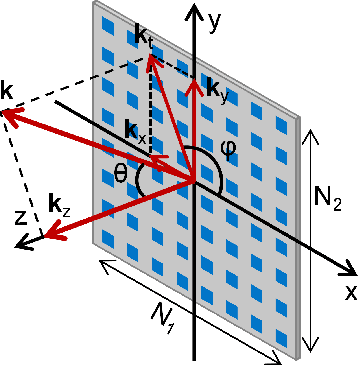
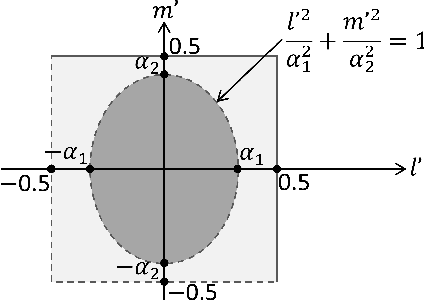
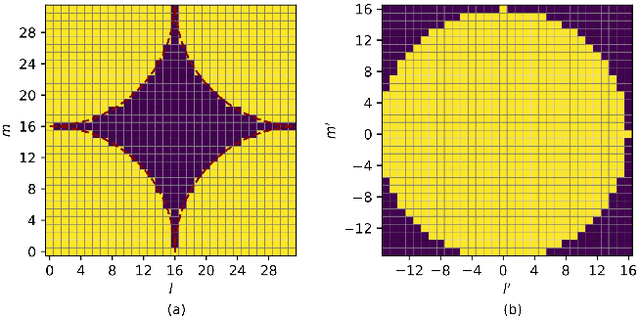
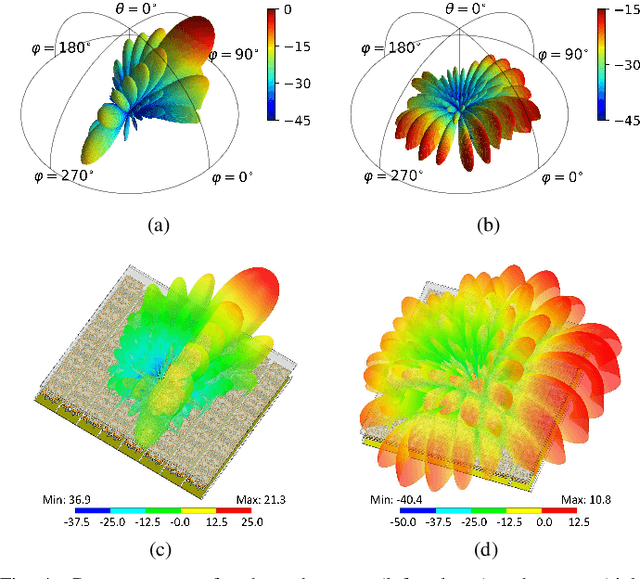
Abstract:The orthogonal bases of discrete Fourier transform (DFT) has been recognized as the standard spatial-domain bases for Type I, Type II and enhanced Type II codewords by the 3rd Generation Partnership Project (3GPP). For uniform planar arrays, these spatial-domain bases are derived as the Kronecker product of one-dimensional DFT bases. Theoretically, each spatial basis corresponds to a beam directed towards a specific angle of departure and the set of bases represent the orthogonal beams that cover the front hemisphere of an array. While the Kronecker-product based precoding scheme facilitates the concise indexing of a codeword in the codebooks through precoding matrix indicators (PMIs) in channel state information feedback, it introduces redundant spatial beams characterized by high spatial-frequency components. This paper investigates the presence of codewords representing high spatial-frequency components within the Kronecker-product based codebooks. Through theoretical analysis and simulations, we confirm the redundancy of these codewords in MIMO communications, advocating for their removal from the codebooks to enhance system performance. Several topics relevant to the high spatial components are also involved in the discussion. Practical suggestions regarding future standard design are provided based on our theoretical analysis and simulation results.
Spatial Non-Stationary Dual-Wideband Channel Estimation for XL-MIMO Systems
Jul 08, 2024Abstract:In this paper, we investigate the channel estimation problem for extremely large-scale multi-input and multi-output (XL-MIMO) systems, considering the spherical wavefront effect, spatially non-stationary (SnS) property, and dual-wideband effects. To accurately characterize the XL-MIMO channel, we first derive a novel spatial-and-frequency-domain channel model for XL-MIMO systems and carefully examine the channel characteristics in the angular-and-delay domain. Based on the obtained channel representation, we formulate XL-MIMO channel estimation as a Bayesian inference problem. To fully exploit the clustered sparsity of angular-and-delay channels and capture the inter-antenna and inter-subcarrier correlations, a Markov random field (MRF)-based hierarchical prior model is adopted. Meanwhile, to facilitate efficient channel reconstruction, we propose a sparse Bayesian learning (SBL) algorithm based on approximate message passing (AMP) with a unitary transformation. Tailored to the MRF-based hierarchical prior model, the message passing equations are reformulated using structured variational inference, belief propagation, and mean-field rules. Finally, simulation results validate the convergence and superiority of the proposed algorithm over existing methods.
Patterned Beam Training: A Novel Low-Complexity and Low-Overhead Scheme for ELAA
Jun 01, 2024


Abstract:Extremely large antenna arrays (ELAAs) can provide higher spectral efficiency. However, the use of narrower beams for data transmission significantly increases the overhead associated with beam training. In this letter, we propose a novel patterned beam training (PBT) scheme characterized by its low overhead and complexity. This scheme requires only a single linear operation by both the base station and the user equipment to determine the optimal beam, reducing the training overhead to half or even less compared to traditional exhaustive search methods. Furthermore, We discuss the pattern design principles in detail and provide specific forms. Simulation results demonstrate that the proposed scheme outperforms the compared methods in terms of beam alignment accuracy and achieves a balance between signal-to-noise ratio (SNR) conditions and training overhead, making it a promising alternative.
Fast Beam Training and Performance Analysis for Extremely Large Aperture Array
Apr 28, 2024Abstract:Extremely large aperture array (ELAA) can significantly enhance beamforming gain and spectral efficiency. Unfortunately, the use of narrower beams for data transmission results in a substantial increase in the cost of beam training. In this paper, we study a high-efficiency and low-overhead scheme named hash beam training. Specifically, two improved hash codebook design methods, random and fixed, are proposed. Moreover, we analyze beam alignment performance. Since the derived beam alignment success probability is a complex function, we also propose a heuristic metric to evaluate the impact of codebook parameter on performance. Finally, simulation results validate the theoretical analysis, indicating that the proposed beam training scheme can achieve fast beam alignment with lower overhead and higher accuracy.
Spatially Non-Stationary XL-MIMO Channel Estimation: A Three-Layer Generalized Approximate Message Passing Method
Mar 05, 2024



Abstract:In this paper, channel estimation problem for extremely large-scale multi-input multi-output (XL-MIMO) systems is investigated with the considerations of the spherical wavefront effect and the spatially non-stationary (SnS) property. Due to the diversities of SnS characteristics among different propagation paths, the concurrent channel estimation of multiple paths becomes intractable. To address this challenge, we propose a two-phase channel estimation scheme. In the first phase, the angles of departure (AoDs) on the user side are estimated, and a carefully designed pilot transmission scheme enables the decomposition of the received signal from different paths. In the second phase, the subchannel estimation corresponding to different paths is formulated as a three-layer Bayesian inference problem. Specifically, the first layer captures block sparsity in the angular domain, the second layer promotes SnS property in the antenna domain, and the third layer decouples the subchannels from the observed signals. To efficiently facilitate Bayesian inference, we propose a novel three-layer generalized approximate message passing (TL-GAMP) algorithm based on structured variational massage passing and belief propagation rules. Simulation results validate the convergence and effectiveness of the proposed algorithm, showcasing its robustness to different channel scenarios.
Joint Visibility Region and Channel Estimation for Extremely Large-scale MIMO Systems
Nov 16, 2023Abstract:In this work, we investigate the channel estimation (CE) problem for extremely large-scale multiple-input-multiple-output (XL-MIMO) systems, considering both the spherical wavefront effect and spatial non-stationarity (SnS). Unlike existing non-stationary CE methods that rely on the statistical characteristics of channels in the spatial or temporal domain, our approach seeks to leverage sparsity in both the spatial and wavenumber domains simultaneously to achieve an accurate estimation.To this end, we introduce a two-stage visibility region (VR) detection and CE framework. Specifically, in the first stage, the belief regarding the visibility of antennas is obtained through a structured message passing (MP) scheme, which fully exploits the block sparse structure of the antenna-domain channel. In the second stage, using the obtained VR information and wavenumber-domain sparsity, we accurately estimate the SnS channel employing the belief-based orthogonal matching pursuit (BB-OMP) method. Simulations demonstrate that the proposed algorithms lead to a significant enhancement in VR detection and CE accuracy, especially in low signal-to-noise ratio (SNR) scenarios.
Reconfigurable Intelligent Surfaces for Energy Efficiency in Full-duplex Communication System
May 24, 2022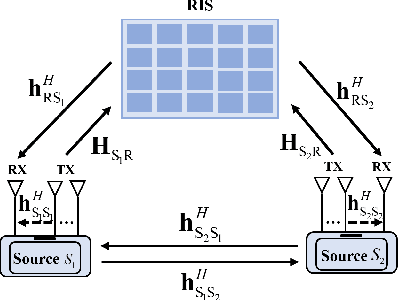
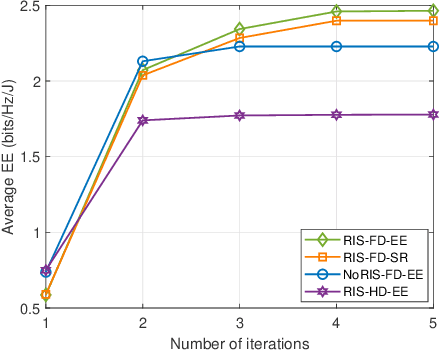
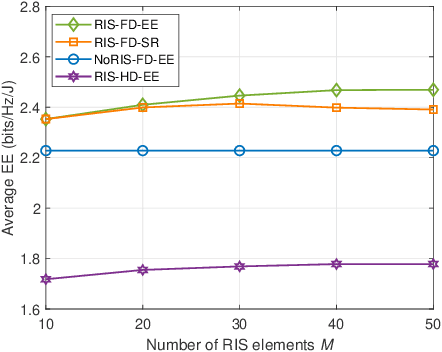
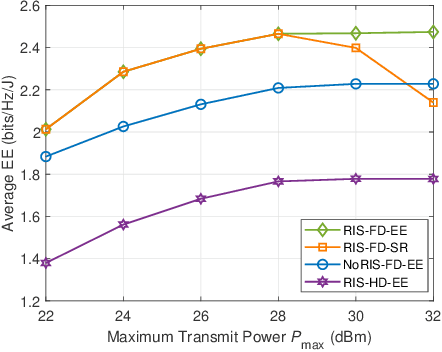
Abstract:In this letter, we study the reconfigurable intelligent surfaces (RIS) aided full-duplex (FD) communication system. By jointly designing the active beamforming of two multi-antenna sources and passive beamforming of RIS, we aim to maximize the energy efficiency of the system, where extra self-interference cancellation power consumption in FD system is also considered. We divide the optimization problem into active and passive beamforming design subproblems, and adopt the alternative optimization framework to solve them iteratively. Dinkelbach's method is used to tackle the fractional objective function in active beamforming problem. Penalty method and successive convex approximation are exploited for passive beamforming design. Simulation results show the energy efficiency of our scheme outperforms other benchmarks.
Distributed and Joint Optimization of Precoding and Power for User-Centric Cell-Free Massive MIMO
May 18, 2022
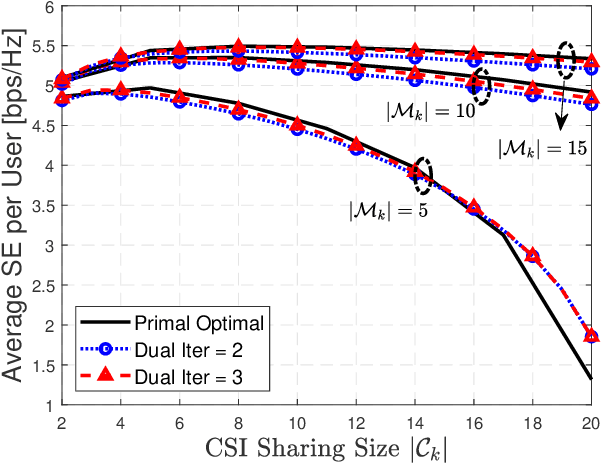
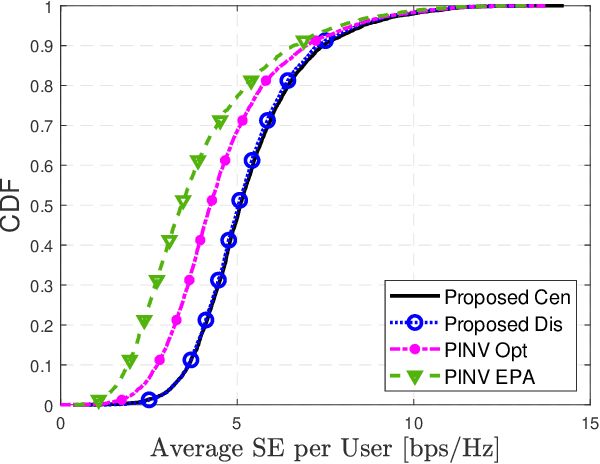
Abstract:In the cell-free massive multiple-input multiple-output (CF mMIMO) system, the centralized transmission scheme is widely adopted to manage the inter-user interference. Unfortunately, its implementation is limited by the extensive signaling overhead between the central process unit (CPU) and the access points (APs). In this letter, we study the downlink transmission scheme in a distributed approach. First, we propose a reduced channel state information (CSI) exchange mechanism, where only the CSI of a portion of users is shared among neighboring APs. Base on this, the dual decomposition method is adopted to jointly optimize the precoder and power control. The precoding vector can be independently calculated by each AP cluster with closed-form expression. With very few iterations, the proposed distributed scheme achieves the same performance as the centralized one. Moreover, it significantly reduces the information exchange to the CPU.
Energy Efficiency Maximization of Simultaneous Transmission and Reflection RIS Assisted Full-Duplex Communications
Mar 14, 2022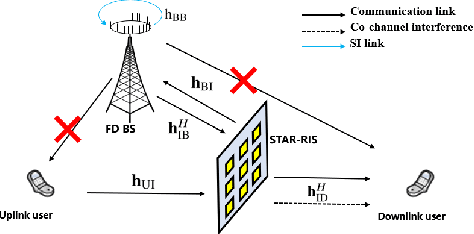
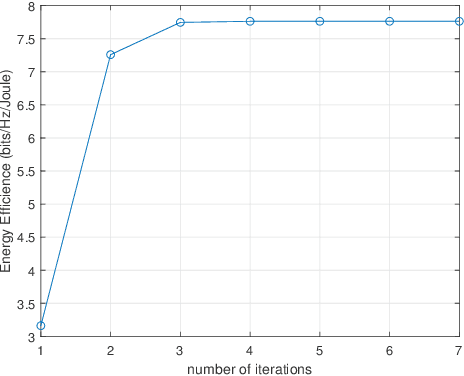
Abstract:This work studies the effectiveness of a novel simultaneous transmission and reflection reconfigurable intelligent surface (STAR-RIS) aided Full-Duplex (FD) communication system. We aim to maximize the energy efficiency by jointly optimizing the transmit power and passive beamforming at the STAR-RIS. We propose an efficient algorithm to optimize them iteratively under the alternating optimization framework. The successive convex approximation (SCA) and Dinkelbach's method are used to solve the power optimization subproblem. The penalty-based method is used to design passive beamforming at the STAR-RIS. Numerical results verify the convergence and effectiveness of the proposed algorithm, and further reveal the benifits of the combining of the STAR-RIS and FD communication compared to benchmarks.
 Add to Chrome
Add to Chrome Add to Firefox
Add to Firefox Add to Edge
Add to Edge